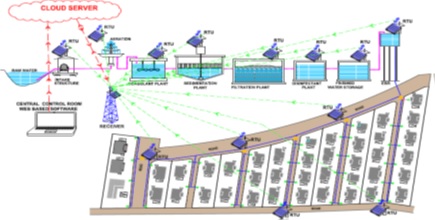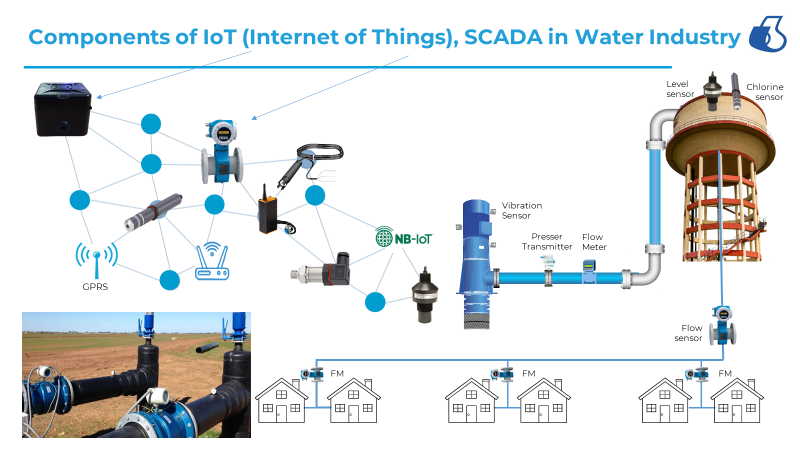By Dilip Yewalekar and Manisha Kinge, Jain Irrigation Systems Ltd., Jalgaon India
Solar power is very curious subject flaming all over the world in all sectors from space station to water management & treatment because of unlimited availability of free solar radiation without proprietorships and non-judicial! Concerning to use of solar power in waste water management sector is in primitive stage because of lack of awareness on design aspects and exceptional types of electro-mechanical machines for waste water management system. In the waste water treatment, all the electromechanical devices are working on electrical power supplied either by Govt or DG Set. So recurring, maintenance, fuel cost & overall energy cost of such waste water treatment plants is significantly higher than solar energy. The concern article throws lights on fundamental & design aspects of solar powered waste water management system, contributes to achieve certain objectives of COP26.
Review Wastewater treatment means removal of impurities from wastewater, before reaching to aquifers or natural bodies of water such as River, Lake, and Oceans. Water pollution, therefore, is caused primarily by the drainage of contaminated waste water into surface water or groundwater. More than 80 percent of the world’s wastewater flows back into the environment without being treated.
Principle Stages of Waste Water Treatment
There are three levels of wastewater treatment: primary, secondary, and tertiary (or advanced 8 Collection tank: To collect raw water / waste water. 8 Bar Screen /Grit: To separate solid matters, debris. 8 Trap: To separate solid matters. 8 Primary clarifier 8 Aeration tank 8 Nutrient removal (if) 8 Secondary clarifier 8 Disinfection 8 Final produce. 8 Sludge holding tank. 8 Sludge Treatment.
Primary treatment Primary treatment removes physical debris by process of screening. Suspended particles that pass through screens and grit chambers are removed from the sewage in sedimentation tanks, Fig. 1. Architect of Solar Powered Waste Water Treatment Plant. called as primary clarifiers Secondary treatment
Secondary treatment removes the soluble organic matter and suspended solids that escapes primary treatment. Removal is usually accomplished by biological processes with microbes.
Disinfections Disinfection is the last step prior to discharge of the sewage effluent into a water body which destroys any remaining pathogens in the effluent & protects public health, is usually done by injection of chlorine bases chemicals.
Change of Electrical Motor Pumpset to Solar Power. Electrical motor pump sets are provided to lift and transfer the sewage from one point to another point for treatment purpose. Special non-clogging pumps are used for this purpose and mainly operated by electrical power. Same electrical motor pumpset can be operated by solar power without making any changes in the entire system. Selection of such motor pumpset is dependent on volume of waste water to be handle and head requirement.
Review Solar Photovoltaic (PV)
The photovoltaic effect refers to photons of light exciting electrons into a higher state of energy, allowing them to act as charge carriers for an electric current. The photovoltaic effect was first observed by Alexander-Edmond Becquerel in Fig. 2. Global solar power available India ANNUAL MEAN DAILY GLOBAL SOLAR ELECTRIC CONVERSION [POTENTIAL INDIA (MW). Solar cells produce direct current electricity from sun light, which can be used to power equipment or to recharge a battery. In this case an inverter is required to convert power DC to AC. Countries positioned (Fig 2 & 3) across the equator have wide scope of harvesting solar power @ 350 w/m2. India is located between equator & tropic of cancer, can harvest solar energy @ 250-350 w/m2 for 6-8 hours consistence throughout the year.
Potential of solar energy decreases while proceeding towards north-south poles @ 3 to 5 % per degree of latitude. However, solar energy harvesting is dependent on temperature, relative humidity, clouds, latitude, longitude and obstructions at the particular location. Therefore, it is necessary to acquire the climatic data from nearest meteorological station. Base on meteorological data, potential of solar energy harvested can be estimated for design purpose along with solar module and allied equipment.
Design considerations Since the solar radiation is available in day time, so entire waste water treatment process has to be completed in a day time only. Obviously all the design calculation is based on the fluctuation of solar radiation from morning to evening and season to season. However, following factors have to be considered while designing waste water treatment.
8 Average solar radiation from morning to evening on monthly and seasonal basis. 8 Inflow of waste water on daily, alternate and monthly basis
. 8 Quality of waste water (water analysis data).
8 Master plan – waste water treatment process and stages.
8 Operation / management of system.
8 Optimization of requirement of motorpump-set (solar powered) 8 Photovoltaic Solar Module.
8 Techno-commercial parameters.
Determine the solar PV energy output of a photovoltaic system. There are various methods and formula available to determine the solar energy. Average solar energy can be harvested to 200-300 Wm-2 at various locations base on latitude and longitude. It varies from season to season and mainly affects the cloud cover and haziness. Maximum solar power can be harvested in summer season and minimum in rainy seasons due to cloudiness. Similarly in a day solar energy is minimum in morning, maximum in noon and again minimum during evening, it is very clear that the design of WWT should be made corresponding to available solar radiation only.
E = A * r * H * PR (Pvsyst(Switzerland), RETScreen (Canada), Synergy Enviro Engineers(Hyd), https:// photovoltaic-software.com/) E – Gross Energy (kwhr) A – Total area of solar panel (sqmt) r – Solar panel yield (%) H – Annual average irradiation on tilted panel PR -Performance ratio, coefficient for losses (range between 0.9 and 0.5, default value = 0.75) NetSE = E*L NetSE- Net Solar Energy (kwhr) L (%) = Power Losses (in Inverters, Temperature, Cables (AC/DC), Shading %,
Weak Irradiation, Dust, snow fall, RH, Cloud cover & unforeseen losses)
However, there are various software available to determine the harvesting of solar power, sunpath and duration as highlighted in figure 5, 6 & 7.
Benefits to Nation
8 Dependency on Government Power supply will be ended and project will become selfsufficient in power.
8 No electrical Bill.
8 Import of fuel, coal, nuclear power will be reduced over great extend and thereby saving in forex.
8 Pollution, environment, ecological & health control can be achieved.
8 Indirectly help to increase GDP.
8 Helps to achieve targeted aims of COP26.
8 Wide scope for employment generation.
Limitations
8 Initial investment is high.
8 Advanced technology in design and manufacturing of solar panel is not available easily
8 Lack of awareness among the department and extension works need to be done.
8 Availability of skilled manpower and special tools





